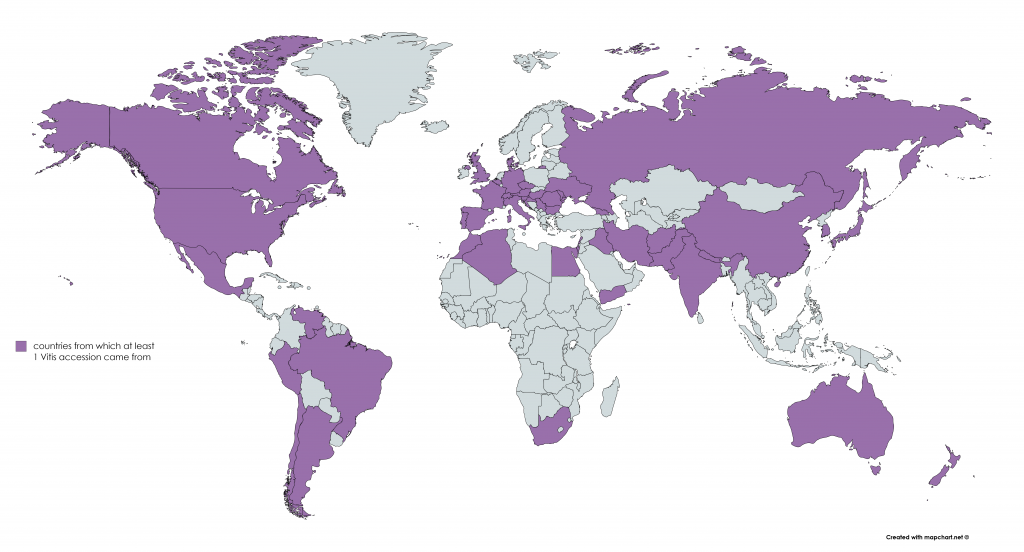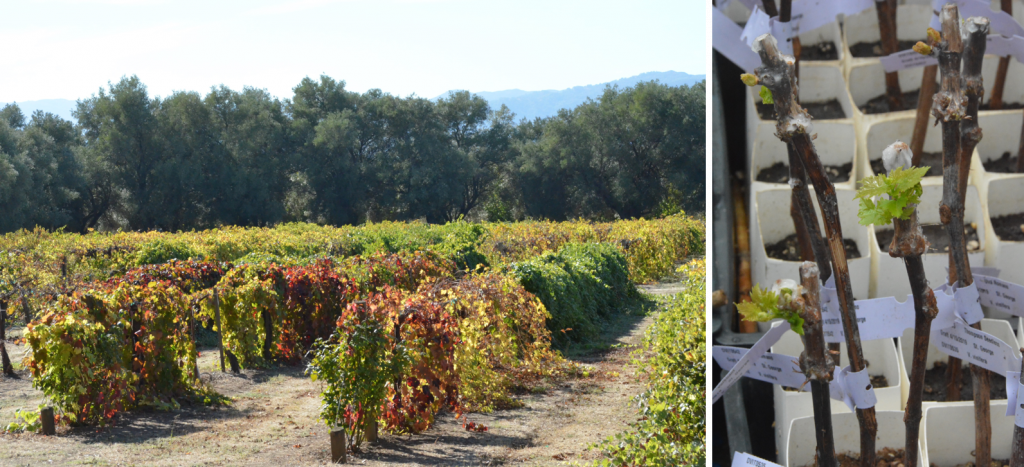Grape Collection
Bernard Prins, USDA-ARS National Clonal Germplasm Repository, One Shields Drive, University of California, Davis, California 95616
Gayle M. Volk, USDA-ARS National Laboratory for Genetic Resources Preservation, 1111 S. Mason St., Fort Collins, Colorado 80521
John E. Preece, USDA-ARS National Clonal Germplasm Repository, One Shields Drive, University of California, Davis, California 95616
Outline
1. Introduction
Vineyards and wineries are present throughout the United States, with California being the largest producer of grapes and wine. Vitis vinifera cultivars are grown for production of fresh fruit, raisins, and wine. These V. vinifera cultivars are vulnerable to biotic and abiotic stresses, and other Vitis species may provide valuable genes for resistance for improved cultivars. For example, breeding programs have used wild species to identify genes of resistance to Pierce’s disease, which is caused by a bacterium (Xylella fastidiosa) and transmitted by the glassy-winged sharpshooter and other insects (Hickey et al., 2019).
Vitis vinifera originated in the Middle East and spread across northern Africa and eastern and central Europe to northern Europe. Vitis vinifera has one ancestral subspecies, V. vinifera spp. sylvestris, that is found in north Africa, and in widely scattered regions from Germany to Spain and across to Eastern Europe. These true V. sylvestris land races are likely sources of important genes, and the Davis repository has >200 individuals representing wild populations. These individuals may offer improved cold hardiness in northerly accessions, shortened growth cycle in accessions from higher elevations, and other traits for climatic adaptation (Grape Crop Germplasm Committee, 2004).
Asia is another center of origin for 10 to 50 Vitis species. Vitis is found in many areas of China from the dry west, the foothills of the northern and southern side of the Himalayas, the very cold northeast near Korea and the hot and humid southeast. Chinese cultivars based on V. amurensis are grown in the northeast of China. These cultivars have relatively large berries, very good cold tolerance and some disease resistance. This species has been utilized in the former Soviet Union as well as Eastern Europe in crosses with V. vinifera to produce numerous hybrid series, widely known for their high levels of cold tolerance and Plasmopara resistance. These hybrids were produced in an attempt to extend the northern range of viticulture, and have also been utilized for breeding in Minnesota, Canada, and Germany (Grape Crop Germplasm Committee, 2004).
North American grape species are found throughout North America from southern Canada to northern South America. There are about 20 species in North America, although that number may be as high as 40 by some accounts. All the species within Vitis are interfertile and they freely hybridize. Some of these species have been hybridized with V. vinifera especially to incorporate Phylloxera resistance; however, the North American genetics added cold hardiness and different flavor profiles.
2. Vitis (Grape) collection
The National Clonal Germplasm Repository for Tree Fruit, Nut Crops, and Grapes (NCGR) Davis, California has 3,649 unique accessions of grapes maintained in duplicate as vines in the field. This collection is the most diverse Vitis collection in the world, representing 42 taxa. The USDA-ARS National Plant Germplasm System has a second collection of Vitis with 1,011 clonal and 117 seed accessions that are maintained at the Plant Genetic Resources Unit in Geneva, New York. This chapter primarily focuses on the Vitis collection in Davis, CA.
Figure 1. Countries from which USDA National Plant Germplasm System Vitis accessions originated. Map made by Emma Balunek.
Figure 2. Field collection of Vitis in the U.S. National Plant Germplasm System, Davis location (left). Grafted Vitis ready to be transplanted to the field collection (right). Photo credit: Gayle Volk.
Figure 3. Vitis plant with flowers (left) and immature fruit (right). Photo credit: Gayle Volk.
Figure 4. Cultivar diversity in the U.S. National Plant Germplasm System Vitis collection. Photo credit: Jean-Carlos Bettoni.
Video 1. Bernard Prins discusses the grape collection.
3. references
Grape Crop Germplasm Committee. 2004. Genetic Vulnerability Statement. https://www.ars-grin.gov/npgs/cgc_reports/grape2004vulnerability.html
Hickey C, Blaauw B, Brannen P. 2019. Pierce’s Disease of Grape: Identification and management. GA Cooperative Extension Bulletin 1514. https://secure.caes.uga.edu/extension/publications/files/pdf/B%201514_1.pdf
4. additional information
Curator: Bernie Prins, USDA-ARS National Clonal Germplasm Repository, One Shields Drive, University of California, Davis, CA 95616-8607, bernard.prins@usda.gov
5. Acknowledgments
Citation: Prins B, Volk GM, Preece JE. 2021. Grape collection. In: Volk GM, Preece JE (Ed.) Field tour of the USDA National Clonal Germplasm Repository for Tree Fruit, Nut Crops, and Grapes in Davis, California. Fort Collins, Colorado: Colorado State University. Date accessed. Available from: https://colostate.pressbooks.pub/davisrepositoryfieldtour/chapter/grapes/
This training module was made possible in part by funding from USDA-ARS, Colorado State University, and the United States Agency for International Development (USAID).
Editors: Emma Balunek, Gayle Volk, Katheryn Chen
This project was funded in part by the National Academy of Sciences (NAS) and USAID, and any opinions, findings, conclusions, or recommendations expressed in such are those of the authors alone, and do not necessarily reflect the views of USAID or NAS. USDA is an equal opportunity provider and employer. Mention of trade names or commercial products in this article is solely for the purpose of providing specific information and does not imply recommendation or endorsement by the US Department of Agriculture.






